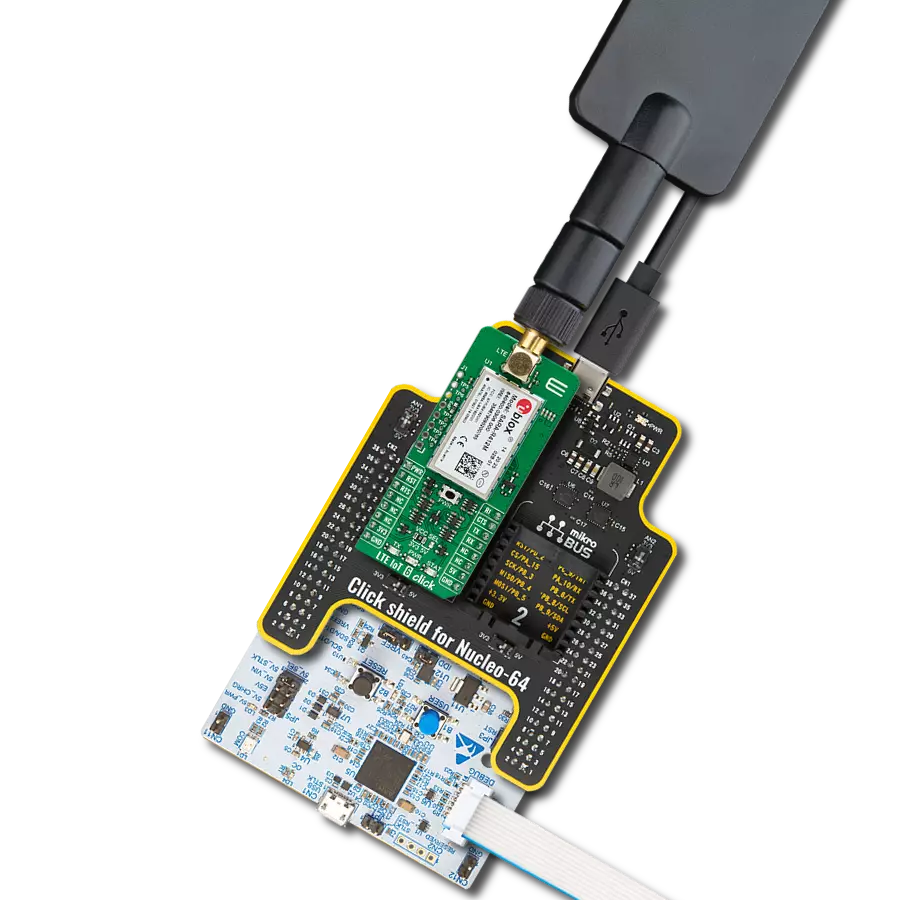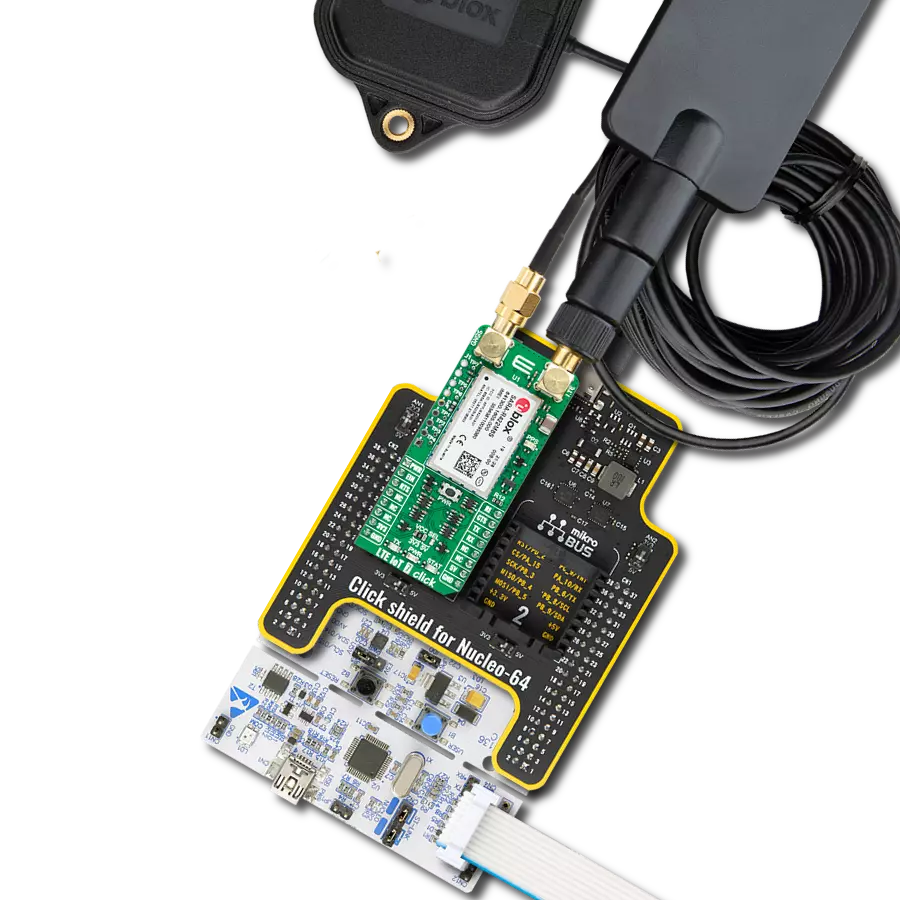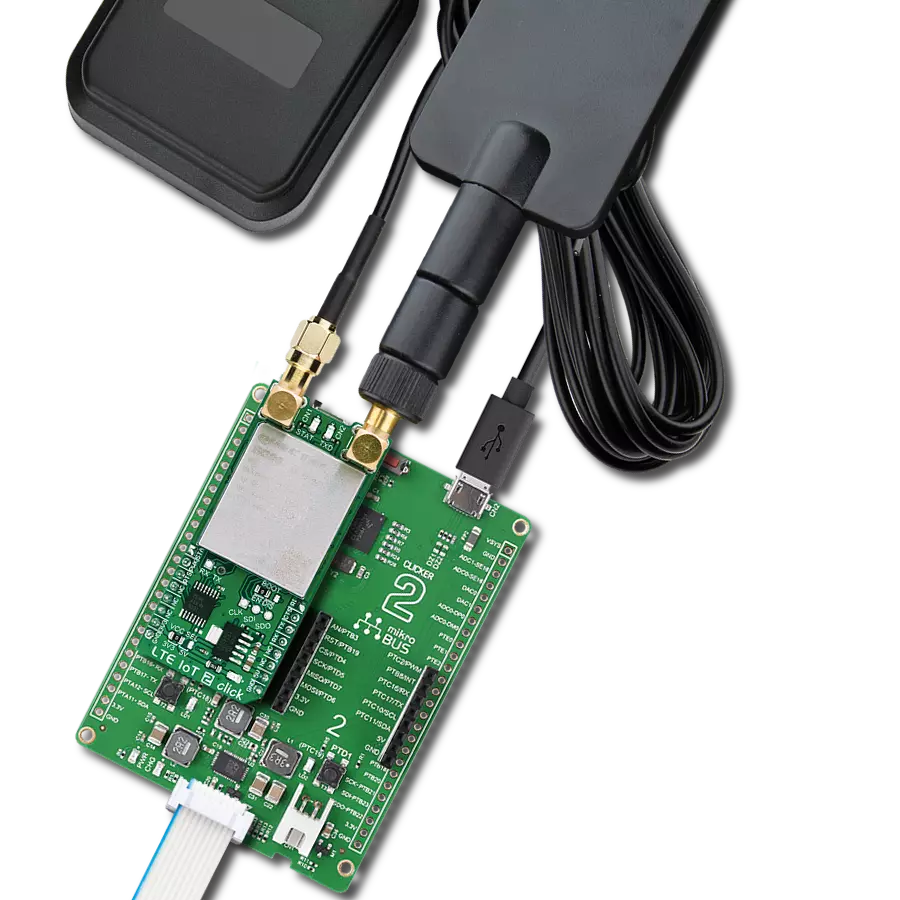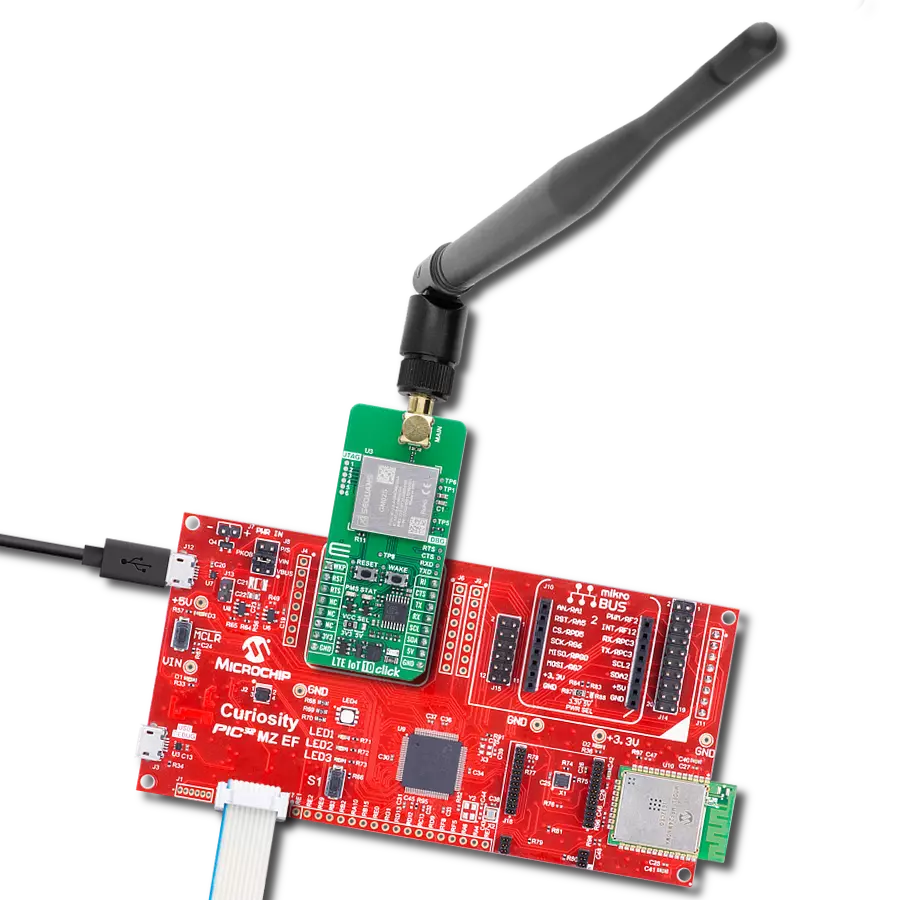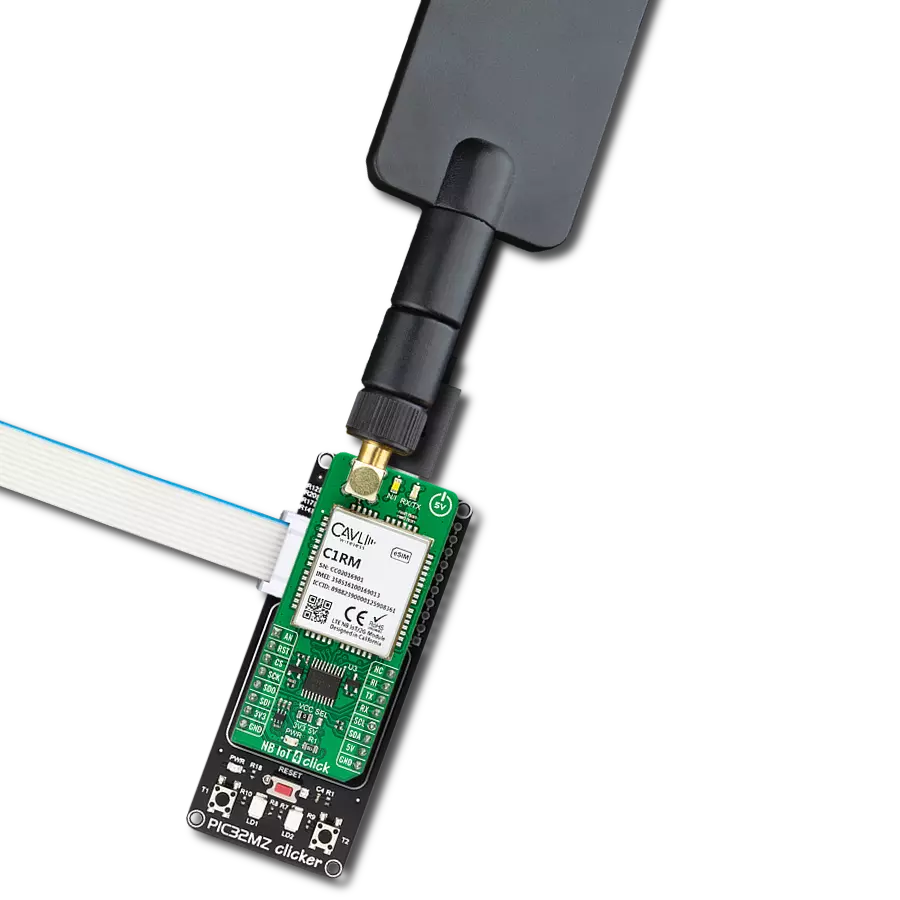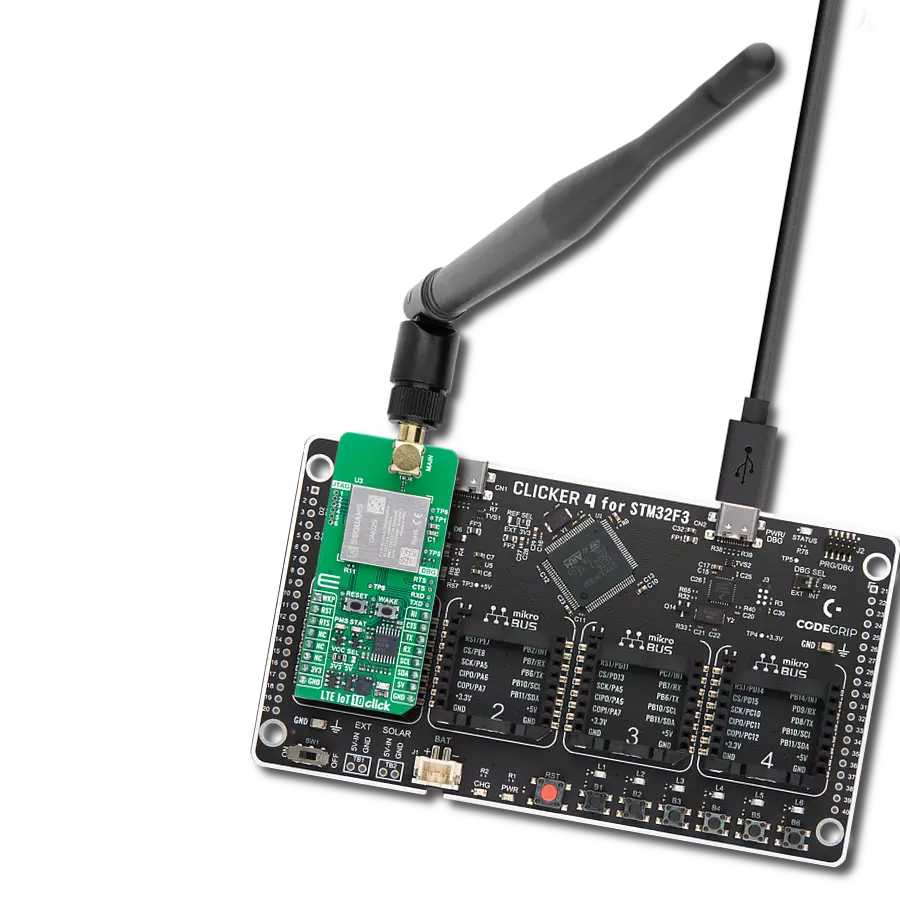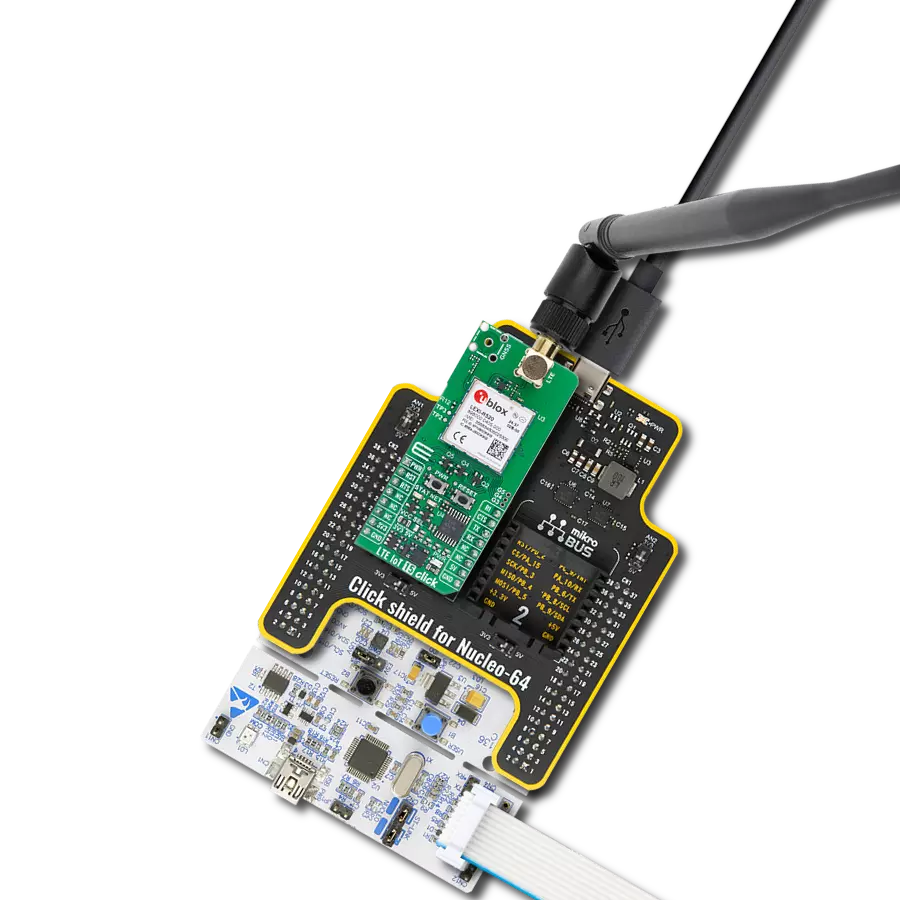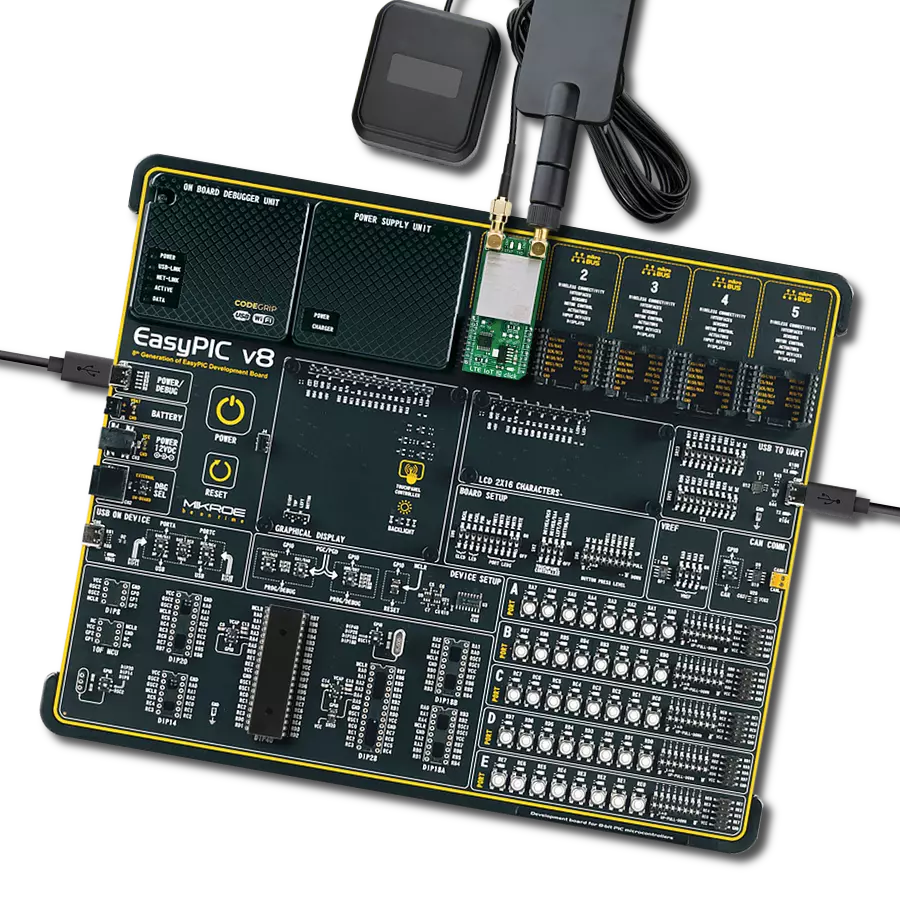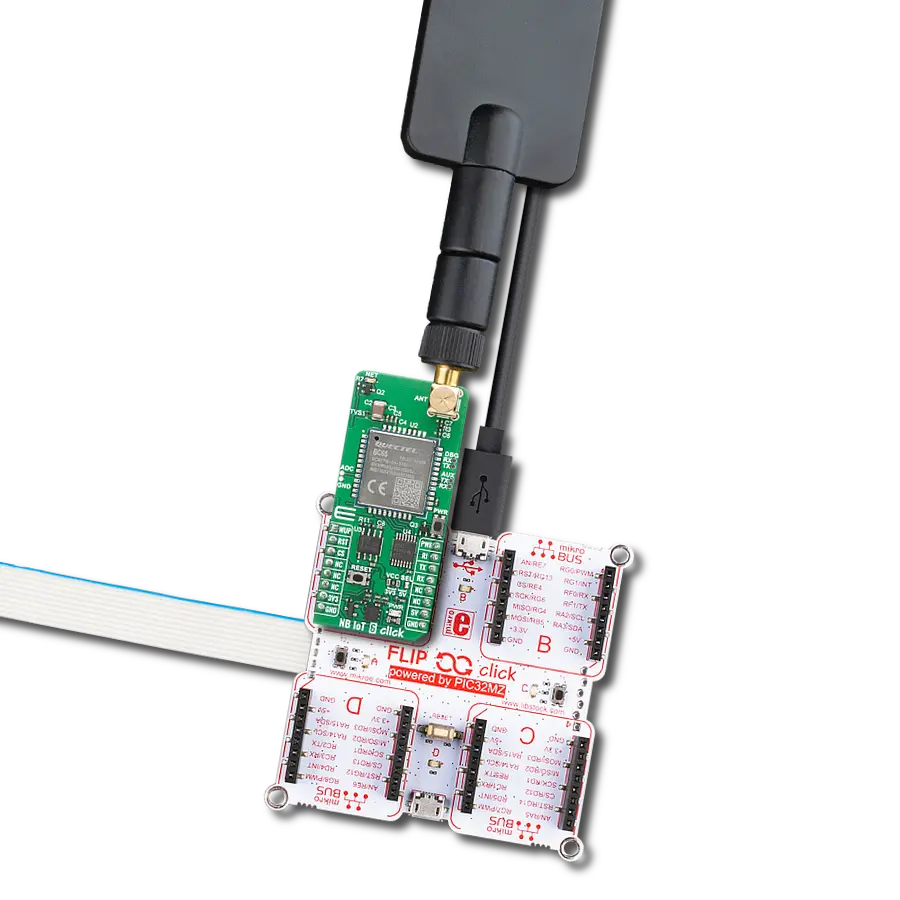Secure-cloud multi-band solution for IoT applications
A
A
Hardware Overview
How does it work?
LTE IoT 7 Click is based on the SARA-R422M8S, a multi-band LTE-M/NB-IoT/EGPRS multi-mode cellular module from Trasna. It comes in a miniature SARA LGA form factor module that is a drop-in migration from other Trasna cellular module families. The SARA-R422M8S modules provide software-based multi-band configurability enabling global coverage in LTE-M / NB-IoT and (E)GPRS radio access technologies, supporting a comprehensive set of 3GPP Rel. 14 features relevant for IoT applications. The SARA-R422M8S module is ideal for mission-critical IoT solutions for its unique and immutable root of trust. It supports IoT Security-as-a-Service, provides the foundation for a trusted set of advanced security functionalities, and offers best-in-class data encryption and decryption, both on-device and from device to cloud. Utilizing the latest (D)TLS stack and cipher suites with hardware-based crypto acceleration provides robust, efficient, and protected communication. This module requires a power supply of 3.8V. Therefore, the Click board™ incorporates an integrated buck (step-down DC-DC) converter, labeled as TPS7A7002 by Texas Instruments, which provides a stable 3.8V power supply, capable of mitigating voltage drops at the
(typically at the StartUp of the device). The SARA-R422M8S communicates with MCU using the UART interface with commonly used UART RX and TX pins with the hardware flow control pins UART CTS, RTS, RI (Clear to Send, Ready to Send, and Ring Indicator). It operates at 115200 bps by default configuration to transmit and exchange data with the host MCU through AT commands that Trasna provides. It is also equipped with a USB type C connector, available for diagnostic purposes only. The module is a USB device and can be connected to any USB host with compatible drivers. The push-button labeled PWR routed to the AN pin on the mikroBUS™ socket represents the Ignition (Power-On) button, where a yellow STAT LED indicates a successful action. Among its used pins, this Click board™ also has a GNSS external interrupt to control the GNSS receiver or to aid. It possesses three additional LED indicators: the yellow STAT LED to visually indicate the device's operational status, a red TX LED to tell the network status, and an orange PPS LED for time pulse signal information and indication. The GNSS RF input of the SARA-R422M8S, designed with 50Ω characteristic impedance and an internal DC block, input when a high current peak appears
is suitable for both active or passive GNSS antennas due to the built-in SAW filter followed by an LNA in front of the integrated high-performing Trasna M8 concurrent positioning engine. Besides those SMA connectors (for LTE and GNSS antennas), the LTE IoT 7 Click also has a Nano-SIM card slot that provides multiple connections and interface options. The J1 header allows you to access the configurable GPIO and GNSS Data output from internal Trasna GNSS, while test points labeled from TP1 to TP6 enable easy FW upgrades and module testing. Customers can future-proof their solutions through over-the-air firmware updates, thanks to the uFOTA client/server solution that utilizes LWM2M, a light and compact protocol ideal for IoT. As mentioned, we have also provided accessible test points directly connected to the TxD and RxD pins for FW upgrade purposes. This Click board™ can operate with either 3.3V or 5V logic voltage levels selected via the VCC SEL jumper. This way, both 3.3V and 5V capable MCUs can use the communication lines properly. However, the Click board™ comes equipped with a library containing easy-to-use functions and an example code that can be used, as a reference, for further development.

Features overview
Development board
EasyPIC PRO v8 is a development board specially designed for the needs of rapid development of embedded applications. It supports many high pin count 8-bit PIC microcontrollers from Microchip, regardless of their number of pins, and a broad set of unique functions, such as the first-ever embedded debugger/programmer over WiFi. The development board is well organized and designed so that the end-user has all the necessary elements, such as switches, buttons, indicators, connectors, and others, in one place. Thanks to innovative manufacturing technology, EasyPIC PRO v8 provides a fluid and immersive working experience, allowing access anywhere and under
any circumstances at any time. Each part of the EasyPIC PRO v8 development board contains the components necessary for the most efficient operation of the same board. In addition to the advanced integrated CODEGRIP programmer/debugger module, which offers many valuable programming/debugging options and seamless integration with the Mikroe software environment, the board also includes a clean and regulated power supply module for the development board. It can use a wide range of external power sources, including a battery, an external 12V power supply, and a power source via the USB Type-C (USB-C) connector.
Communication options such as USB-UART, USB DEVICE, and Ethernet are also included, including the well-established mikroBUS™ standard, a standardized socket for the MCU card (SiBRAIN standard), and two display options (graphical and character-based LCD). EasyPIC PRO v8 is an integral part of the Mikroe ecosystem for rapid development. Natively supported by Mikroe software tools, it covers many aspects of prototyping and development thanks to a considerable number of different Click boards™ (over a thousand boards), the number of which is growing every day.
Microcontroller Overview
MCU Card / MCU

Type
8th Generation
Architecture
PIC
MCU Memory (KB)
64
Silicon Vendor
Microchip
Pin count
80
RAM (Bytes)
3904
You complete me!
Accessories
GNSS Active External Antenna is a unique multi-band type of antenna coming from u-blox that is the perfect selection for high precision GNSS applications, which require highly accurate location abilities such as RTK. The ANN-MB-00 is a multi-band (L1, L2/E5b/B2I) active GNSS antenna with a 5m cable and SMA connector. The antenna supports GPS, GLONASS, Galileo, and BeiDou and includes a high-performance multi-band RHCP dual-feed patch antenna element, a built-in high-gain LNA with SAW pre-filtering, and a 5 m antenna cable with SMA connector, and is waterproof.
LTE Flat Rotation Antenna is a versatile choice for boosting the performance of 3G/4G LTE devices. With a wide frequency range of 700-2700MHz, it ensures optimal connectivity on major cellular bands worldwide. This flat antenna features an SMA male connector, making it easy to attach directly to your device or SMA module connector. One of its standout features is its adjustable angle, which can be set in 45⁰ increments (0⁰/45⁰/90⁰), allowing you to fine-tune the antenna's orientation for maximum signal reception. With an impedance of 50Ω and a VSW Ratio of <2.0:1, this antenna ensures a reliable and efficient connection. Its 5dB gain, vertical polarization, and omnidirectional radiation pattern enhance signal strength, making it suitable for various applications. Measuring 196mm in length and 38mm in width, this antenna offers a compact yet effective solution for improving your connectivity. With a maximum input power of 50W, it can handle the demands of various devices.
Used MCU Pins
mikroBUS™ mapper
Take a closer look
Click board™ Schematic

Step by step
Project assembly
Software Support
Library Description
This library contains API for LTE IoT 7 Click driver.
Key functions:
lteiot7_set_sim_apnThis function sets APN for a sim card.lteiot7_send_sms_textThis function sends a text message to a phone number.lteiot7_parse_gpggaThis function parses the GPGGA data from the read response buffer.
Open Source
Code example
The complete application code and a ready-to-use project are available through the NECTO Studio Package Manager for direct installation in the NECTO Studio. The application code can also be found on the MIKROE GitHub account.
/*!
* @file main.c
* @brief LTE IoT 7 Click Example.
*
* # Description
* Application example shows device capability of connecting to the network and
* sending SMS or TCP/UDP messages, or retrieving data from GNSS using standard "AT" commands.
*
* The demo application is composed of two sections :
*
* ## Application Init
* Initializes the driver, reboots the module which takes about 20 seconds and then tests the communication.
*
* ## Application Task
* Application task is split in few stages:
* - LTEIOT7_CONFIGURE_FOR_NETWORK:
* Sets configuration to device to be able to connect to the network. (used only for SMS or TCP/UDP demo examples).
*
* - LTEIOT7_WAIT_FOR_CONNECTION:
* Waits for the network registration indicated via CREG URC event and then checks
* the connection status (used only for SMS or TCP/UDP demo examples).
*
* - LTEIOT7_CONFIGURE_FOR_EXAMPLE:
* Sets the device configuration for sending SMS or TCP/UDP messages or for retrieving data from GNSS
* depending on the selected demo example.
*
* - LTEIOT7_EXAMPLE:
* Depending on the selected demo example, it sends an SMS message (in PDU or TXT mode) or TCP/UDP message or
* waits for the GPS fix to retrieve location info from GNSS.
*
* By default, the TCP/UDP example is selected.
*
* ## Additional Function
* - static void lteiot7_clear_app_buf ( void )
* - static err_t lteiot7_process ( void )
* - static void lteiot7_error_check( err_t error_flag )
* - static void lteiot7_log_app_buf ( void )
* - static err_t lteiot7_rsp_check ( void )
* - static err_t lteiot7_configure_for_connection( void )
* - static err_t lteiot7_check_connection( void )
* - static err_t lteiot7_configure_for_messages( void )
* - static err_t lteiot7_send_message( void )
*
* @note
* In order for the examples to work (except GNSS example), user needs to set the APN and SMSC (SMS PDU mode only)
* of entered SIM card as well as the phone number (SMS mode only) to which he wants to send an SMS.
* Enter valid values for the following macros: SIM_APN, SIM_SMSC and PHONE_NUMBER_TO_MESSAGE.
* Example:
SIM_APN "internet"
SIM_SMSC "+381610401"
PHONE_NUMBER_TO_MESSAGE "+381659999999"
*
* @author Stefan Filipovic
*
*/
#include "board.h"
#include "log.h"
#include "lteiot7.h"
#include "generic_pointer.h"
#include "conversions.h"
// Example selection macros
#define EXAMPLE_TCP_UDP 0 // Example of sending messages to a TCP/UDP echo server
#define EXAMPLE_SMS 1 // Example of sending SMS to a phone number
#define EXAMPLE_GNSS 2 // Example of retrieving location info from GNSS
#define DEMO_EXAMPLE EXAMPLE_TCP_UDP // Example selection macro
// SIM APN config
#define SIM_APN "" // Set valid SIM APN
// SMS example parameters
#define SIM_SMSC "" // Set valid SMS Service Center Address - only in SMS PDU mode
#define PHONE_NUMBER_TO_MESSAGE "" // Set Phone number to message
#define SMS_MODE "1" // SMS mode: "0" - PDU, "1" - TXT
// TCP/UDP example parameters
#define REMOTE_IP "77.46.162.162" // TCP/UDP echo server IP address
#define REMOTE_PORT "51111" // TCP/UDP echo server port
// Message content
#define MESSAGE_CONTENT "LTE IoT 7 Click board - demo example."
// Application buffer size
#define PROCESS_BUFFER_SIZE 300
/**
* @brief Example states.
* @details Predefined enum values for application example state.
*/
typedef enum
{
LTEIOT7_CONFIGURE_FOR_NETWORK = 1,
LTEIOT7_WAIT_FOR_CONNECTION,
LTEIOT7_CONFIGURE_FOR_EXAMPLE,
LTEIOT7_EXAMPLE
} lteiot7_example_state_t;
static lteiot7_t lteiot7;
static log_t logger;
/**
* @brief Application example variables.
* @details Variables used in application example.
*/
static char app_buf[ PROCESS_BUFFER_SIZE ] = { 0 };
static int32_t app_buf_len = 0;
static int32_t app_buf_cnt = 0;
static err_t error_flag;
static lteiot7_example_state_t example_state;
/**
* @brief Clearing application buffer.
* @details This function clears memory of application
* buffer and reset its length and counter.
*/
static void lteiot7_clear_app_buf ( void );
/**
* @brief Data reading function.
* @details This function reads data from device and
* appends it to the application buffer.
* @return @li @c 0 - Some data is read.
* @li @c -1 - Nothing is read.
* See #err_t definition for detailed explanation.
*/
static err_t lteiot7_process ( void );
/**
* @brief Check for errors.
* @details This function checks for different types of
* errors and logs them on UART or logs the response if no errors occured.
*/
static void lteiot7_error_check( err_t error_flag );
/**
* @brief Logs application buffer.
* @details This function logs data from application buffer.
*/
static void lteiot7_log_app_buf ( void );
/**
* @brief Response check.
* @details This function checks for response and
* returns the status of response.
* @return @li @c 0 - OK response.
* @li @c -2 - Timeout error.
* @li @c -3 - Command error.
* @li @c -4 - Unknown error.
* See #err_t definition for detailed explanation.
*/
static err_t lteiot7_rsp_check ( void );
/**
* @brief Configure device for connection to the network.
* @details Sends commands to configure and enable
* connection to the specified network.
* @return @li @c 0 - OK response.
* @li @c -2 - Timeout error.
* @li @c -3 - Command error.
* @li @c -4 - Unknown error.
* See #err_t definition for detailed explanation.
*/
static err_t lteiot7_configure_for_network( void );
/**
* @brief Wait for connection signal.
* @details Wait for connection signal from CREG URC.
* @return @li @c 0 - OK response.
* @li @c -2 - Timeout error.
* @li @c -3 - Command error.
* @li @c -4 - Unknown error.
* See #err_t definition for detailed explanation.
*/
static err_t lteiot7_check_connection( void );
/**
* @brief Configure device for example.
* @details Configure device for the specified example.
* @return @li @c 0 - OK response.
* @li @c -2 - Timeout error.
* @li @c -3 - Command error.
* @li @c -4 - Unknown error.
* See #err_t definition for detailed explanation.
*/
static err_t lteiot7_configure_for_example( void );
/**
* @brief Execute example.
* @details This function executes SMS, TCP/UDP or GNSS example depending on the DEMO_EXAMPLE macro.
* @return @li @c 0 - OK response.
* @li @c -2 - Timeout error.
* @li @c -3 - Command error.
* @li @c -4 - Unknown error.
* See #err_t definition for detailed explanation.
*/
static err_t lteiot7_example( void );
void application_init ( void )
{
log_cfg_t log_cfg; /**< Logger config object. */
lteiot7_cfg_t lteiot7_cfg; /**< Click config object. */
/**
* Logger initialization.
* Default baud rate: 115200
* Default log level: LOG_LEVEL_DEBUG
* @note If USB_UART_RX and USB_UART_TX
* are defined as HAL_PIN_NC, you will
* need to define them manually for log to work.
* See @b LOG_MAP_USB_UART macro definition for detailed explanation.
*/
LOG_MAP_USB_UART( log_cfg );
log_init( &logger, &log_cfg );
log_info( &logger, " Application Init " );
// Click initialization.
lteiot7_cfg_setup( <eiot7_cfg );
LTEIOT7_MAP_MIKROBUS( lteiot7_cfg, MIKROBUS_1 );
if ( UART_ERROR == lteiot7_init( <eiot7, <eiot7_cfg ) )
{
log_error( &logger, " Application Init Error. " );
log_info( &logger, " Please, run program again... " );
for ( ; ; );
}
lteiot7_set_power_state ( <eiot7, LTEIOT7_POWER_STATE_REBOOT );
lteiot7_process( );
lteiot7_clear_app_buf( );
app_buf_len = 0;
app_buf_cnt = 0;
// Check communication
lteiot7_send_cmd( <eiot7, LTEIOT7_CMD_AT );
error_flag = lteiot7_rsp_check( );
lteiot7_error_check( error_flag );
log_info( &logger, " Application Task " );
example_state = LTEIOT7_CONFIGURE_FOR_NETWORK;
}
void application_task ( void )
{
switch ( example_state )
{
case LTEIOT7_CONFIGURE_FOR_NETWORK:
{
if ( LTEIOT7_OK == lteiot7_configure_for_network( ) )
{
example_state = LTEIOT7_WAIT_FOR_CONNECTION;
}
break;
}
case LTEIOT7_WAIT_FOR_CONNECTION:
{
if ( LTEIOT7_OK == lteiot7_check_connection( ) )
{
example_state = LTEIOT7_CONFIGURE_FOR_EXAMPLE;
}
break;
}
case LTEIOT7_CONFIGURE_FOR_EXAMPLE:
{
if ( LTEIOT7_OK == lteiot7_configure_for_example( ) )
{
example_state = LTEIOT7_EXAMPLE;
}
break;
}
case LTEIOT7_EXAMPLE:
{
lteiot7_example( );
break;
}
default:
{
log_error( &logger, " Example state." );
break;
}
}
}
int main ( void )
{
/* Do not remove this line or clock might not be set correctly. */
#ifdef PREINIT_SUPPORTED
preinit();
#endif
application_init( );
for ( ; ; )
{
application_task( );
}
return 0;
}
static void lteiot7_clear_app_buf ( void )
{
memset( app_buf, 0, app_buf_len );
app_buf_len = 0;
app_buf_cnt = 0;
}
static err_t lteiot7_process ( void )
{
int32_t rx_size;
char rx_buff[ PROCESS_BUFFER_SIZE ] = { 0 };
rx_size = lteiot7_generic_read( <eiot7, rx_buff, PROCESS_BUFFER_SIZE );
if ( rx_size > 0 )
{
int32_t buf_cnt = 0;
if ( ( app_buf_len + rx_size ) > PROCESS_BUFFER_SIZE )
{
lteiot7_clear_app_buf( );
return LTEIOT7_ERROR;
}
else
{
buf_cnt = app_buf_len;
app_buf_len += rx_size;
}
for ( int32_t rx_cnt = 0; rx_cnt < rx_size; rx_cnt++ )
{
if ( rx_buff[ rx_cnt ] != 0 )
{
app_buf[ ( buf_cnt + rx_cnt ) ] = rx_buff[ rx_cnt ];
}
else
{
app_buf_len--;
buf_cnt--;
}
}
return LTEIOT7_OK;
}
return LTEIOT7_ERROR;
}
static err_t lteiot7_rsp_check ( void )
{
uint32_t timeout_cnt = 0;
uint32_t timeout = 120000;
err_t error_flag = lteiot7_process( );
if ( ( LTEIOT7_OK != error_flag ) && ( LTEIOT7_ERROR != error_flag ) )
{
return error_flag;
}
while ( ( 0 == strstr( app_buf, LTEIOT7_RSP_OK ) ) &&
( 0 == strstr( app_buf, LTEIOT7_RSP_ERROR ) ) )
{
error_flag = lteiot7_process( );
if ( ( LTEIOT7_OK != error_flag ) && ( LTEIOT7_ERROR != error_flag ) )
{
return error_flag;
}
if ( timeout_cnt++ > timeout )
{
lteiot7_clear_app_buf( );
return LTEIOT7_ERROR_TIMEOUT;
}
Delay_ms ( 1 );
}
if ( strstr( app_buf, LTEIOT7_RSP_OK ) )
{
return LTEIOT7_OK;
}
else if ( strstr( app_buf, LTEIOT7_RSP_ERROR ) )
{
return LTEIOT7_ERROR_CMD;
}
else
{
return LTEIOT7_ERROR_UNKNOWN;
}
}
static void lteiot7_error_check( err_t error_flag )
{
switch ( error_flag )
{
case LTEIOT7_OK:
{
lteiot7_log_app_buf( );
break;
}
case LTEIOT7_ERROR:
{
log_error( &logger, " Overflow!" );
break;
}
case LTEIOT7_ERROR_TIMEOUT:
{
log_error( &logger, " Timeout!" );
break;
}
case LTEIOT7_ERROR_CMD:
{
log_error( &logger, " CMD!" );
break;
}
case LTEIOT7_ERROR_UNKNOWN:
default:
{
log_error( &logger, " Unknown!" );
break;
}
}
lteiot7_clear_app_buf( );
Delay_ms ( 500 );
}
static void lteiot7_log_app_buf ( void )
{
for ( int32_t buf_cnt = 0; buf_cnt < app_buf_len; buf_cnt++ )
{
log_printf( &logger, "%c", app_buf[ buf_cnt ] );
}
}
static err_t lteiot7_configure_for_network( void )
{
err_t func_error = LTEIOT7_OK;
#if ( ( DEMO_EXAMPLE == EXAMPLE_TCP_UDP ) || ( DEMO_EXAMPLE == EXAMPLE_SMS ) )
// Deregister from network
#define DEREGISTER_FROM_NETWORK "2"
lteiot7_send_cmd_with_parameter( <eiot7, LTEIOT7_CMD_COPS, DEREGISTER_FROM_NETWORK );
error_flag = lteiot7_rsp_check();
func_error |= error_flag;
lteiot7_error_check( error_flag );
// Set SIM APN
lteiot7_set_sim_apn( <eiot7, SIM_APN );
error_flag = lteiot7_rsp_check();
func_error |= error_flag;
lteiot7_error_check( error_flag );
// Enable full functionality
#define FULL_FUNCTIONALITY "1"
lteiot7_send_cmd_with_parameter( <eiot7, LTEIOT7_CMD_CFUN, FULL_FUNCTIONALITY );
error_flag = lteiot7_rsp_check();
func_error |= error_flag;
lteiot7_error_check( error_flag );
// Automatic registration
#define AUTOMATIC_REGISTRATION "0"
lteiot7_send_cmd_with_parameter( <eiot7, LTEIOT7_CMD_COPS, AUTOMATIC_REGISTRATION );
error_flag = lteiot7_rsp_check();
func_error |= error_flag;
lteiot7_error_check( error_flag );
// Enable network registartion
#define ENABLE_REG "2"
lteiot7_send_cmd_with_parameter( <eiot7, LTEIOT7_CMD_CREG, ENABLE_REG );
error_flag = lteiot7_rsp_check();
func_error |= error_flag;
lteiot7_error_check( error_flag );
#endif
return func_error;
}
static err_t lteiot7_check_connection( void )
{
#if ( ( DEMO_EXAMPLE == EXAMPLE_TCP_UDP ) || ( DEMO_EXAMPLE == EXAMPLE_SMS ) )
#define CONNECTED "+CREG: 1"
lteiot7_process( );
if ( strstr( app_buf, CONNECTED ) )
{
Delay_ms ( 100 );
lteiot7_process( );
lteiot7_log_app_buf( );
log_printf( &logger, "\r\n" );
lteiot7_clear_app_buf( );
// Check signal quality
lteiot7_send_cmd( <eiot7, LTEIOT7_CMD_CSQ );
error_flag = lteiot7_rsp_check( );
lteiot7_error_check( error_flag );
return error_flag;
}
return LTEIOT7_ERROR;
#endif
return LTEIOT7_OK;
}
static err_t lteiot7_configure_for_example( void )
{
err_t func_error = LTEIOT7_OK;
#if ( DEMO_EXAMPLE == EXAMPLE_TCP_UDP )
#define ACTIVATE_PDP_CONTEXT "1,1"
lteiot7_send_cmd_with_parameter( <eiot7, LTEIOT7_CMD_CGACT, ACTIVATE_PDP_CONTEXT );
error_flag = lteiot7_rsp_check( );
func_error |= error_flag;
lteiot7_error_check( error_flag );
#elif ( DEMO_EXAMPLE == EXAMPLE_SMS )
lteiot7_send_cmd_with_parameter( <eiot7, LTEIOT7_CMD_CMGF, SMS_MODE );
error_flag = lteiot7_rsp_check( );
func_error |= error_flag;
lteiot7_error_check( error_flag );
#elif ( DEMO_EXAMPLE == EXAMPLE_GNSS )
lteiot7_send_cmd_check( <eiot7, LTEIOT7_CMD_UGPS );
error_flag = lteiot7_rsp_check( );
func_error |= error_flag;
#define GPS_POWERED_OFF "+UGPS: 0"
if ( strstr( app_buf, GPS_POWERED_OFF ) )
{
#define ENABLE_GPS "1,0,1"
lteiot7_send_cmd_with_parameter( <eiot7, LTEIOT7_CMD_UGPS, ENABLE_GPS );
error_flag = lteiot7_rsp_check( );
func_error |= error_flag;
lteiot7_error_check( error_flag );
Delay_ms ( 1000 );
}
#define ENABLE_NMEA_GGA "1"
lteiot7_send_cmd_with_parameter( <eiot7, LTEIOT7_CMD_UGGGA, ENABLE_NMEA_GGA );
error_flag = lteiot7_rsp_check( );
func_error |= error_flag;
lteiot7_error_check( error_flag );
#else
#error "No demo example selected"
#endif
return func_error;
}
static err_t lteiot7_example( void )
{
err_t func_error = LTEIOT7_OK;
#if ( DEMO_EXAMPLE == EXAMPLE_TCP_UDP )
char cmd_buf[ 100 ] = { 0 };
char urc_buf[ 20 ] = { 0 };
uint16_t timeout_cnt = 0;
uint16_t timeout = 30000;
uint8_t * __generic_ptr socket_num_buf = 0;
uint8_t tcp_socket_num[ 2 ] = { 0 };
uint8_t udp_socket_num[ 2 ] = { 0 };
// Create TCP socket
#define RSP_USOCR "+USOCR: "
#define TCP_PROTOCOL "6"
lteiot7_send_cmd_with_parameter( <eiot7, LTEIOT7_CMD_USOCR, TCP_PROTOCOL );
error_flag = lteiot7_rsp_check( );
func_error |= error_flag;
socket_num_buf = strstr( app_buf, RSP_USOCR ) + strlen ( RSP_USOCR );
tcp_socket_num[ 0 ] = *socket_num_buf;
lteiot7_error_check( error_flag );
// Create UDP socket
#define UDP_PROTOCOL "17"
lteiot7_send_cmd_with_parameter( <eiot7, LTEIOT7_CMD_USOCR, UDP_PROTOCOL );
error_flag = lteiot7_rsp_check( );
func_error |= error_flag;
socket_num_buf = strstr( app_buf, RSP_USOCR ) + strlen ( RSP_USOCR );
udp_socket_num[ 0 ] = *socket_num_buf;
lteiot7_error_check( error_flag );
// Connect TCP socket to remote IP and port
strcpy( cmd_buf, tcp_socket_num );
strcat( cmd_buf, ",\"" );
strcat( cmd_buf, REMOTE_IP );
strcat( cmd_buf, "\"," );
strcat( cmd_buf, REMOTE_PORT );
lteiot7_send_cmd_with_parameter( <eiot7, LTEIOT7_CMD_USOCO, cmd_buf );
error_flag = lteiot7_rsp_check( );
func_error |= error_flag;
lteiot7_error_check( error_flag );
// Connect UDP socket to remote IP and port
strcpy( cmd_buf, udp_socket_num );
strcat( cmd_buf, ",\"" );
strcat( cmd_buf, REMOTE_IP );
strcat( cmd_buf, "\"," );
strcat( cmd_buf, REMOTE_PORT );
lteiot7_send_cmd_with_parameter( <eiot7, LTEIOT7_CMD_USOCO, cmd_buf );
error_flag = lteiot7_rsp_check( );
func_error |= error_flag;
lteiot7_error_check( error_flag );
// Get message length
uint8_t message_len_buf[ 5 ] = { 0 };
uint16_t message_len = strlen( MESSAGE_CONTENT );
uint16_to_str( message_len, message_len_buf );
l_trim( message_len_buf );
r_trim( message_len_buf );
// Write message to TCP socket
strcpy( cmd_buf, tcp_socket_num );
strcat( cmd_buf, "," );
strcat( cmd_buf, message_len_buf );
strcat( cmd_buf, ",\"" );
strcat( cmd_buf, MESSAGE_CONTENT );
strcat( cmd_buf, "\"" );
lteiot7_send_cmd_with_parameter( <eiot7, LTEIOT7_CMD_USOWR, cmd_buf );
error_flag = lteiot7_rsp_check( );
func_error |= error_flag;
lteiot7_error_check( error_flag );
// Read response message from TCP socket
#define URC_READ_SOCKET_DATA_TCP "+UUSORD: "
strcpy( urc_buf, URC_READ_SOCKET_DATA_TCP );
strcat( urc_buf, tcp_socket_num );
for ( ; ; )
{
lteiot7_process( );
uint8_t * __generic_ptr start_response_buf = strstr( app_buf, urc_buf );
if ( start_response_buf )
{
Delay_ms ( 100 );
lteiot7_process( );
uint8_t response_len_buf[ 5 ] = { 0 };
char * __generic_ptr start_response_len = strstr( start_response_buf, "," ) + 1;
memcpy ( response_len_buf, start_response_len, app_buf_len - ( start_response_len - app_buf ) );
strcpy( cmd_buf, tcp_socket_num );
strcat( cmd_buf, "," );
strcat( cmd_buf, response_len_buf );
lteiot7_log_app_buf( );
lteiot7_clear_app_buf( );
lteiot7_send_cmd_with_parameter( <eiot7, LTEIOT7_CMD_USORD, cmd_buf );
error_flag = lteiot7_rsp_check( );
func_error |= error_flag;
lteiot7_error_check( error_flag );
break;
}
if ( timeout_cnt++ > timeout )
{
break;
}
Delay_ms ( 1 );
}
timeout_cnt = 0;
// Write message to UDP socket
strcpy( cmd_buf, udp_socket_num );
strcat( cmd_buf, "," );
strcat( cmd_buf, message_len_buf );
strcat( cmd_buf, ",\"" );
strcat( cmd_buf, MESSAGE_CONTENT );
strcat( cmd_buf, "\"" );
lteiot7_send_cmd_with_parameter( <eiot7, LTEIOT7_CMD_USOWR, cmd_buf );
error_flag = lteiot7_rsp_check( );
func_error |= error_flag;
lteiot7_error_check( error_flag );
// Read response message from UDP socket
#define URC_READ_SOCKET_DATA_UDP "+UUSORF: "
strcpy( urc_buf, URC_READ_SOCKET_DATA_UDP );
strcat( urc_buf, udp_socket_num );
for ( ; ; )
{
lteiot7_process( );
uint8_t * __generic_ptr start_response_buf = strstr( app_buf, urc_buf );
if ( start_response_buf )
{
Delay_ms ( 100 );
lteiot7_process( );
uint8_t response_len_buf[ 5 ] = { 0 };
char * __generic_ptr start_response_len = strstr( start_response_buf, "," ) + 1;
memcpy ( response_len_buf, start_response_len, app_buf_len - ( start_response_len - app_buf ) );
strcpy( cmd_buf, udp_socket_num );
strcat( cmd_buf, "," );
strcat( cmd_buf, response_len_buf );
lteiot7_log_app_buf( );
lteiot7_clear_app_buf( );
lteiot7_send_cmd_with_parameter( <eiot7, LTEIOT7_CMD_USORF, cmd_buf );
error_flag = lteiot7_rsp_check( );
func_error |= error_flag;
lteiot7_error_check( error_flag );
break;
}
if ( timeout_cnt++ > timeout )
{
break;
}
Delay_ms ( 1 );
}
// Close TCP socket
lteiot7_send_cmd_with_parameter( <eiot7, LTEIOT7_CMD_USOCL, tcp_socket_num );
error_flag = lteiot7_rsp_check( );
func_error |= error_flag;
lteiot7_error_check( error_flag );
// Close UDP socket
lteiot7_send_cmd_with_parameter( <eiot7, LTEIOT7_CMD_USOCL, udp_socket_num );
error_flag = lteiot7_rsp_check( );
func_error |= error_flag;
lteiot7_error_check( error_flag );
Delay_ms ( 1000 );
Delay_ms ( 1000 );
Delay_ms ( 1000 );
Delay_ms ( 1000 );
Delay_ms ( 1000 );
#elif ( DEMO_EXAMPLE == EXAMPLE_SMS )
// Check SMS mode
#define CMGF_PDU "+CMGF: 0"
#define CMGF_TXT "+CMGF: 1"
lteiot7_send_cmd_check( <eiot7, LTEIOT7_CMD_CMGF );
error_flag = lteiot7_rsp_check( );
func_error |= error_flag;
if ( strstr( app_buf, CMGF_PDU ) )
{
lteiot7_error_check( error_flag );
// Send SMS in PDU mode
lteiot7_send_sms_pdu( <eiot7, SIM_SMSC, PHONE_NUMBER_TO_MESSAGE, MESSAGE_CONTENT );
error_flag = lteiot7_rsp_check( );
func_error |= error_flag;
}
else if ( strstr( app_buf, CMGF_TXT ) )
{
lteiot7_error_check( error_flag );
// Send SMS in TXT mode
lteiot7_send_sms_text ( <eiot7, PHONE_NUMBER_TO_MESSAGE, MESSAGE_CONTENT );
error_flag = lteiot7_rsp_check( );
func_error |= error_flag;
}
lteiot7_error_check( error_flag );
// 30 seconds delay
Delay_ms ( 1000 );
Delay_ms ( 1000 );
Delay_ms ( 1000 );
Delay_ms ( 1000 );
Delay_ms ( 1000 );
Delay_ms ( 1000 );
Delay_ms ( 1000 );
Delay_ms ( 1000 );
Delay_ms ( 1000 );
Delay_ms ( 1000 );
Delay_ms ( 1000 );
Delay_ms ( 1000 );
Delay_ms ( 1000 );
Delay_ms ( 1000 );
Delay_ms ( 1000 );
Delay_ms ( 1000 );
Delay_ms ( 1000 );
Delay_ms ( 1000 );
Delay_ms ( 1000 );
Delay_ms ( 1000 );
Delay_ms ( 1000 );
Delay_ms ( 1000 );
Delay_ms ( 1000 );
Delay_ms ( 1000 );
Delay_ms ( 1000 );
Delay_ms ( 1000 );
Delay_ms ( 1000 );
Delay_ms ( 1000 );
Delay_ms ( 1000 );
Delay_ms ( 1000 );
#elif ( DEMO_EXAMPLE == EXAMPLE_GNSS )
lteiot7_send_cmd_check( <eiot7, LTEIOT7_CMD_UGGGA );
error_flag = lteiot7_rsp_check( );
func_error |= error_flag;
if ( app_buf_len > ( sizeof ( LTEIOT7_RSP_GPGGA ) + LTEIOT7_GPGGA_ELEMENT_SIZE ) )
{
char element_buf[ 100 ] = { 0 };
if ( LTEIOT7_OK == lteiot7_parse_gpgga( app_buf, LTEIOT7_GPGGA_LATITUDE, element_buf ) )
{
static uint8_t wait_for_fix_cnt = 0;
if ( strlen( element_buf ) > 0 )
{
log_printf( &logger, "\r\n Latitude: %.2s degrees, %s minutes \r\n", element_buf, &element_buf[ 2 ] );
lteiot7_parse_gpgga( app_buf, LTEIOT7_GPGGA_LONGITUDE, element_buf );
log_printf( &logger, " Longitude: %.3s degrees, %s minutes \r\n", element_buf, &element_buf[ 3 ] );
memset( element_buf, 0, sizeof( element_buf ) );
lteiot7_parse_gpgga( app_buf, LTEIOT7_GPGGA_ALTITUDE, element_buf );
log_printf( &logger, " Altitude: %s m \r\n", element_buf );
wait_for_fix_cnt = 0;
}
else
{
if ( wait_for_fix_cnt % 5 == 0 )
{
log_printf( &logger, " Waiting for the position fix...\r\n\n" );
wait_for_fix_cnt = 0;
}
wait_for_fix_cnt++;
}
lteiot7_clear_app_buf( );
}
}
Delay_ms ( 1000 );
#else
#error "No demo example selected"
#endif
return func_error;
}
// ------------------------------------------------------------------------ END
Additional Support
Resources
Category:LTE IoT



















